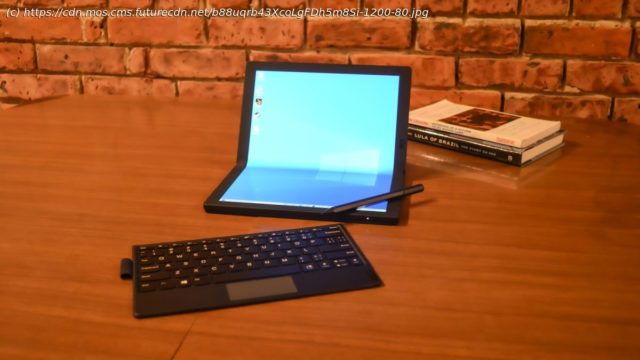The Lenovo ThinkPad X1 Fold is a remarkable and gorgeous innovation, but its very underwhelming performance makes it hard to recommend for the price.
When we first looked at the Lenovo ThinkPad X1 Fold at CES 2020, we definitely saw it as the direction mobile computing was going to take in the coming years, and that is still very much the case — the Lenovo ThinkPad X1 Fold just isn’t it. There is a lot about the Lenovo ThinkPad X1 Fold that we like – even love – but the kind of radical innovation it accomplishes comes at a very steep cost both in terms of price as well as performance and battery life. The Lenovo ThinkPad X1 Fold has an incredibly sleek and well-designed form factor. It’s very hard to think of a laptop that isn’t just a variation of every other clamshell laptop out there. The X1 Fold is more of a book than anything, an aesthetic that is reinforced by the leather back of the display. When folded, the X1 Fold could literally sit on a bookshelf and if anyone notices it at all, it’ll be to say how classy it is – like an expensive, leather-bound hardcover of some important work. Leave it on a table and it catches the eye with it’s slim, glossy strip along the edge, the Core i5 logo in the corner the only hint that this isn’t a very expensive Moleskin journal. The Core i5 logo is deceptive though. The processor beneath the luxurious cover is more like a low-powered Celeron than an i5 you might be used to in any other laptop. The Intel Lakefield hybrid architecture allows the entire system fit in an ultra-thin, hinged, two-panel chassis, but it really doesn’t hold up well to serious use. As a business-oriented device, the graphics performance might not be too much of a concern, but the general CPU performance — both single-core and multi-core — mean that you can do a lot of things with this laptop, you just need to do them all one at a time — and even then, it won’t do it especially well. For the price, there are far, far better laptops out there, they just won’t be foldable, or look as good as the Lenovo ThinkPad X1 Fold. That’s probably the point, since this is definitely the kind of business device that is marketed towards a pretty specific kind of customer: those with money to drop on a device they don’t really need to use very effectively but which will let them stand out in a crowd of similarly dressed business types tapping away on laptops in a conference room or in an airport waiting area. If that’s you, this will definitely accomplish that goal. You are paying a premium here to be an early adopter, but you’re going to be getting an early preview on the future of mobile computing the same way shoe-sized cell phones in the 1980s paved the way for the iPhone. The Lenovo ThinkPad X1 Fold is available now on Lenovo’s site or through other retailers, but it’s definitely not cheap. Starting at $2,499 / £2,519 / AU$3,799 (without the Bluetooth keyboard and, in the US and Australia, without the Lenovo Mod Pen), you’ll have to spend at least $2,749 / £3,089 / AU$ 4,179 to get the X1 Fold with a stylus and keyboard. The only option on the X1 Fold is 8GB RAM, but from there, you can opt for either Windows 10 Home or Windows 10 Pro and a 256GB/512GB/1TB PCIe SSD, with the most expensive configurations costing you $3,099 / £3,209 / AU$6,199 (just note that in the UK, the most you can get is a 512GB SSD). As the world’s first foldable laptop, it’s hard to quite know how to describe the Lenovo ThinkPad X1 Fold. With the keyboard and stylus, it’s a fully functional laptop, but that doesn’t quite capture it. Without the keyboard and stylus, we’d be tempted to call the display or base configuration a tablet, because that’s kind of what it is, but that really undersells the design. This is a fully functional Windows 10 64-bit laptop, so it doesn’t run into the same compatibility issues that a Windows on ARM laptop has (the X1 Fold was able to run every single benchmark test we threw at it, for example, unlike a Windows-on-ARM system like the Lenovo Flex 5G), so we’re definitely in some uncharted waters.






